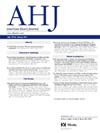诊断心绞痛后无阻塞性冠状动脉疾病(ANOCA)的急诊就诊和住院情况。
IF 3.7
2区 医学
Q1 CARDIAC & CARDIOVASCULAR SYSTEMS
引用次数: 0
摘要
无阻塞性冠状动脉疾病(ANOCA)心绞痛提出了诊断和治疗的挑战,显著负担医疗资源。本研究评估了ANOCA和稳定性心绞痛(SA)合并阻塞性冠状动脉疾病(CAD)诊断后的急诊科(ED)就诊和住院情况,以及与这些结果相关的因素。方法:从阿尔伯塔省冠心病结局评估项目(APPROACH)数据库中回顾性提取2002年至2017年在阿尔伯塔省因胸痛首次行有创心导管术的个体。计算急诊科就诊和住院的发病率(IRs),并使用Cox模型分析与这些结果相关的因素。结果:我们的分析包括28,881人(ANOCA, 36%)。ANOCA患者置管后两年ED就诊的ir为100.3-119.3 / 1000人年,并随着时间的推移而增加(非标准化β系数[b]=2.19 /两年[95%CI 0.83-3.55];p=0.008);SA合并阻塞性CAD的ir为209.3-240.2 / 1000人年,保持稳定(b=-1.83 /两年[95% CI -5.73 - 1.70];p = 0.25)。住院率为12.4-25.8 / 1000人年,ANOCA的住院率稳定(b=-0.93 /两年[95% CI -2.49-0.64];p=0.20);对于伴有阻塞性CAD的SA,其死亡率为106.4-171.4 / 1000人年,并随着时间的推移而下降(b=-9.02 /两年)[95% CI -13.27至-4.77;p = 0.002)。既往心力衰竭史与急诊科就诊最相关(HR= 1.74 [95% CI 1.41-2.14];结论:ANOCA的ED就诊次数随着时间的推移而增加,而住院率保持稳定,表明尽管与SA合并阻塞性CAD相比,ANOCA的发生率普遍较低,但其负担仍在增加。这些发现强调需要更有效的管理策略来解决ANOCA的显著发病率和资源利用问题。本文章由计算机程序翻译,如有差异,请以英文原文为准。
Emergency department visits and hospitalizations after a diagnosis of angina with no obstructive coronary artery disease (ANOCA)
Background
Angina with no obstructive coronary artery disease (ANOCA) presents diagnostic and treatment challenges, significantly burdening healthcare resources. This study assessed emergency department (ED) visits and hospitalizations and factors associated with these outcomes following ANOCA and stable angina (SA) with obstructive coronary artery disease (CAD) diagnoses.
Methods
A retrospective cohort of individuals who had their first invasive cardiac catheterization for chest pain in Alberta from 2002 to 2017 was extracted retrospectively from the Alberta Provincial Project for Outcome Assessment in Coronary Heart Disease (APPROACH) database. Incidence rates (IRs) were calculated for ED visits and hospitalizations, while factors associated with these outcomes were analyzed using Cox models.
Results
Our analysis included 28,881 individuals (ANOCA, 36%). Two-year postcatheterization IRs of ED visits were 100.3-119.3 per 1,000 person-years for ANOCA and increased over time (unstandardized beta coefficient [b] = 2.19 per biennium [95% CI 0.83-3.55]; P = .008); for SA with obstructive CAD the IRs were 209.3-240.2 per 1,000 person-years and remained stable (b = −1.83 per biennium [95% CI −5.73 to 1.70]; P = .25). IRs of hospitalizations were 12.4-25.8 per 1,000 person-years and stable for ANOCA (b = −0.93 per biennium [95% CI −2.49 to 0.64]; P = .20); for SA with obstructive CAD, they were 106.4-171.4 per 1,000 person-years and decreased over time (b = −9.02 per biennium [95% CI −13.27 to −4.77; P = .002). A previous history of heart failure was most associated with ED visits (HR = 1.74 [95% CI 1.41-2.14]; P < .001) and hospitalizations (HR = 2.40 [95% CI 1.82-3.18]; P < .001) for ANOCA.
Conclusions
ED visits for ANOCA have risen over time while hospitalizations remain stable, indicating a growing burden despite generally lower rates than SA with obstructive CAD. These findings underscore the need for more effective management strategies to address the significant morbidity and resource utilization in ANOCA.
求助全文
通过发布文献求助,成功后即可免费获取论文全文。
去求助
来源期刊

American heart journal
医学-心血管系统
CiteScore
8.20
自引率
2.10%
发文量
214
审稿时长
38 days
期刊介绍:
The American Heart Journal will consider for publication suitable articles on topics pertaining to the broad discipline of cardiovascular disease. Our goal is to provide the reader primary investigation, scholarly review, and opinion concerning the practice of cardiovascular medicine. We especially encourage submission of 3 types of reports that are not frequently seen in cardiovascular journals: negative clinical studies, reports on study designs, and studies involving the organization of medical care. The Journal does not accept individual case reports or original articles involving bench laboratory or animal research.
 求助内容:
求助内容: 应助结果提醒方式:
应助结果提醒方式:


